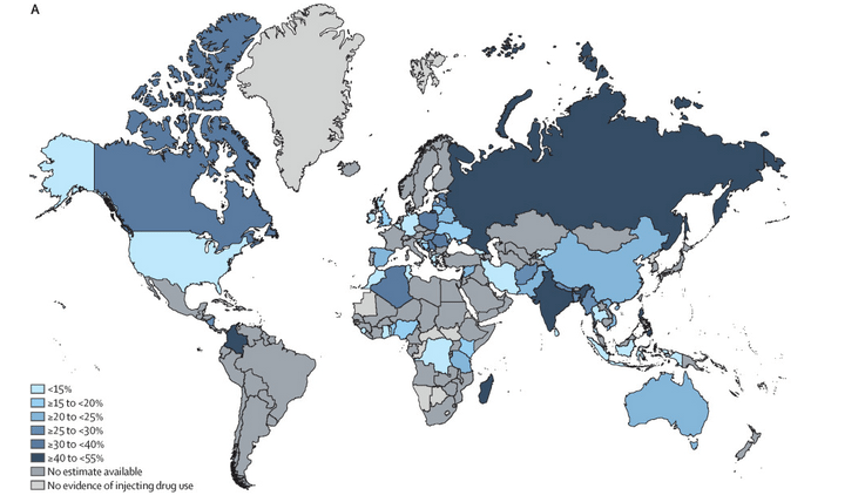
 Dr Lindsey Hines, Sir Henry Wellcome Postdoctoral Fellow in The Centre for Academic Mental Health & the Integrative Epidemiology Unit, University of Bristol
Dr Lindsey Hines, Sir Henry Wellcome Postdoctoral Fellow in The Centre for Academic Mental Health & the Integrative Epidemiology Unit, University of Bristol
Dr Adam Trickey, Senior Research Associate in Population Health Sciences, University of Bristol
Follow Lindsey on Twitter
Injecting drug use is a global issue: around the world an estimated 15.6 million people inject psychoactive drugs. People who inject drugs tend to begin doing so in adolescence, and countries that have larger numbers of adolescents who inject drugs may be at risk of emerging epidemics of blood borne viruses unless they take urgent action. We mapped the global differences in the proportion of adolescents who inject drugs, but found that we may be missing the vital data we need to protect the lives of vulnerable young people. If we want to prevent HIV, hepatitis C, and overdose from sweeping through a new generation of adolescents we urgently need many countries to scale up harm reduction interventions, and to collect accurate which can inform public health and policy.
People who inject drugs are engaging in a behaviour that can expose them to multiple health risks such as addiction, blood-borne viruses, and overdose, and are often stigmatised. New generations of young people are still starting to inject drugs, and young people who inject drugs are often part of other vulnerable groups.
Much of the research into the causes of injecting drug use focuses on individual factors, but we wanted to explore the effect of global development on youth injecting. A recent systematic review showed wide country-level variation in the number of young people who comprise the population of people who inject drugs. By considering variation in countries, we hoped to be able to inform prevention and intervention efforts.
It’s important to note that effective interventions can reduce the harms of injecting drug use. Harm reduction programmes provide clean needles and syringes to reduce transmission of blood borne viruses. Opiate substitution therapy seeks to tackle the physical dependence on opiates that maintains injecting behaviour and has been shown to improve health outcomes.
What we did
Through a global systematic review and meta-analysis we aimed to find data on injecting drug use in published studies, public health and policy documents from every country. We used these data to estimate the global percentage of people who inject drugs that are aged 15-25 years old, and also estimated this for each region and country. We wanted to understand what might underlie variation in the number of young people in populations of people who inject drugs, and so we used data from the World Bank to identify markers of a country’s wealth, equality, and development.
What we found
Our study estimated that, globally, around a quarter of people who inject drugs are adolescents and young adults. Applied to the global population, we can estimate approximately 3·9 million young people inject drugs. As a global average, people start injecting drugs at 23 years old.

We found huge variation in the percentage of young people in each country’s population of people who inject drugs. Regionally, Eastern Europe had the highest proportion of young people amongst their populations who inject drugs, and the Middle Eastern and North African region had the lowest. In both Russia and the Philippines, over 50% of the people who inject drugs were aged 25 or under, and the average age of the populations of people who inject drugs was amongst the lowest observed.

In relation to global development indicators, people who inject drugs were younger in countries with lower wealth (indicated through Gross Domestic Product per capita) had been injecting drugs for a shorter time period. In rapidly urbanising countries (indicated through urbanisation growth rate) people were likely to start injecting drugs at later ages than people in countries with a slower current rate of urbanisation. We didn’t find any relationships between the age of people who inject drugs and a country’s youth unemployment, economic equality, or level provision of opiate substitution therapy.
However, many countries were missing data on injecting age and behaviours, or injecting drug use in general, which could affect these results.
What this means
1. The epidemic of injecting drug use is being maintained over time.
A large percentage of people who inject drugs are adolescents, meaning that a new generation are being exposed to the risks of injecting – and we found that this risk was especially high in less wealthy countries.
2. We need to scale up access to harm reduction interventions
There are highly punitive policies towards drug use in the countries with the largest numbers of young people in their populations of people who inject drugs. Since 2016, thousands of people who use drugs in the Philippines have died at the hands of the police. In contrast, Portugal has adopted a public health approach to drug use and addiction for decades, taking the radical step of taking people caught with drugs or personal use into addiction services rather than prisons. The rate of drug-related deaths and HIV infections in Portugal has since plummeted, as has the overall rate of drug use amongst young people: our data show that Portugal has a high average age for its population of people who inject drugs. If we do not want HIV, hepatitis C, and drug overdoses to sweep through a new generation of adolescents, we urgently need to see more countries adopting the approach pioneered by Portugal, and scaling up access to harm reduction interventions to the levels recommended by the WHO.
3. We need to think about population health, and especially mental health, alongside urban development.
Global development appears to be linked to injecting drug use, and the results suggest that countries with higher urbanisation growth are seeing new, older populations beginning to inject drugs. It may be that changes in environment are providing opportunities for injecting drug use that people hadn’t previously had. It’s estimated that almost 70% of the global population will live in urban areas by 2050, with most of this growth driven by low and middle-income countries.
4. We need to collect accurate data
Despite the health risks of injecting drug use, and the urgent need to reduce risks for new generations, our study has revealed a paucity of data monitoring this behaviour. Most concerning, we know the least about youth injecting drug use in low- and middle-income countries: areas likely to have the highest numbers of young people in their populations of people who inject drugs. Due to the stigma and the illicit nature of injecting drug use it is often under-studied, but by failing to collect accurate data to inform public health and policy we are risking the lives of vulnerable young people.
Contact the researchers
Lindsey is funded by the Wellcome Trust.
